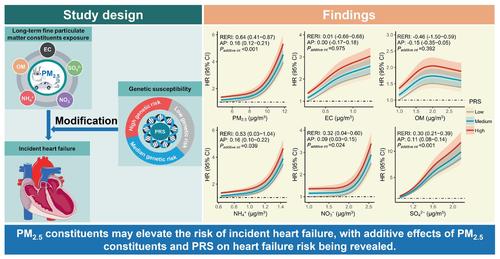当前位置:
X-MOL 学术
›
Eur. J. Heart Fail.
›
论文详情
Our official English website, www.x-mol.net, welcomes your
feedback! (Note: you will need to create a separate account there.)
Long‐term exposure to fine particulate matter constituents, genetic susceptibility, and incident heart failure among 411 807 adults
European Journal of Heart Failure ( IF 16.9 ) Pub Date : 2024-10-23 , DOI: 10.1002/ejhf.3486 Feipeng Cui, Lei Zheng, Jing Zhang, Linxi Tang, Yudiyang Ma, Dankang Li, Jianing Wang, Meiqi Xing, Junqing Xie, Jian Yang, Yaohua Tian
European Journal of Heart Failure ( IF 16.9 ) Pub Date : 2024-10-23 , DOI: 10.1002/ejhf.3486 Feipeng Cui, Lei Zheng, Jing Zhang, Linxi Tang, Yudiyang Ma, Dankang Li, Jianing Wang, Meiqi Xing, Junqing Xie, Jian Yang, Yaohua Tian

|
AimsLong‐term fine particulate matter (PM2.5 ) exposure has been linked to incident heart failure (HF), but the impacts of its constituents remain unknown. We aimed to investigate the associations of PM2.5 constituents with incident HF, and further evaluate the modification effects of genetic susceptibility.Methods and resultsPM2.5 and its constituents, including elemental carbon (EC), organic matter (OM), ammonium (NH4 + ), nitrate (NO3 − ), and sulfate (SO4 2− ), were estimated using the European Monitoring and Evaluation Programme model applied to the UK (EMEP4UK) driven by Weather and Research Forecast model meteorology. A polygenic risk score (PRS) was calculated to represent genetic susceptibility to HF. We employed Cox models to evaluate the associations of PM2.5 constituents with incident HF. Quantile‐based g‐computation model was used to identify the main contributor of PM2.5 constituents. Among 411 807 individuals in the UK Biobank, 7554 participants developed HF during a median follow‐up of 12.05 years. The adjusted hazard ratios of HF for each interquartile range increase in PM2.5 , EC, OM, NH4 + , NO3 − , and SO4 2− were 1.50 (1.46–1.54), 1.31 (1.27–1.34), 1.12 (1.09–1.15), 1.42 (1.41–1.44), 1.26 (1.23–1.29), and 1.25 (1.24–1.26), respectively. EC (43%) played the most important role, followed by NH4 + and SO4 2− . Moreover, synergistic additive interactions accounted for 9–16% of the HF events in individuals exposed to both PM2.5 , NH4 + , NO3 − , and SO4 2− and PRS.ConclusionLong‐term exposure to PM2.5 constituents may elevate HF risk, and EC was the major contributor. Additive effects of PM2.5 constituents and PRS on HF risk were revealed.
中文翻译:

411 807 名成年人长期暴露于细颗粒物成分、遗传易感性和心力衰竭事件
目的长期细颗粒物 (PM2.5) 暴露与心力衰竭 (HF) 事件有关,但其成分的影响仍然未知。我们旨在调查 PM2.5 成分与新发 HF 的相关性,并进一步评估遗传易感性的修饰效应。方法和结果PM2.5 及其成分,包括元素碳 (EC)、有机物 (OM)、铵 (NH4+)、硝酸盐 (NO3−) 和硫酸盐 (SO42−),使用应用于英国 (EMEP4UK) 的欧洲监测和评估计划模型估计由天气和研究预报模型气象学驱动。计算多基因风险评分 (PRS) 以代表 HF 的遗传易感性。我们采用 Cox 模型来评估 PM2.5 成分与事件 HF 的关联。基于分位数的 g 计算模型用于确定 PM2.5 成分的主要贡献者。在英国生物样本库的 411 807 人中,有 7554 名参与者在中位随访 12.05 年期间发生 HF。PM2.5、EC、OM、NH4+、NO3− 和 SO42− 每个四分位距增加的 HF 调整后风险比分别为 1.50 (1.46-1.54)、1.31 (1.27-1.34)、1.12 (1.09-1.15)、1.42 (1.41-1.44)、1.26 (1.23-1.29) 和 1.25 (1.24-1.26)。EC (43%) 起着最重要的作用,其次是 NH4+ 和 SO42−。此外,在暴露于 PM2.5、NH4+、NO3− 和 SO42− 以及 PRS 的个体中,协同加性相互作用占 HF 事件的 9-16%。结论长期暴露于 PM2.5 成分可能会增加 HF 风险,其中 EC 是主要因素。揭示了 PM2.5 成分和 PRS 对 HF 风险的累加效应。
更新日期:2024-10-23
中文翻译:

411 807 名成年人长期暴露于细颗粒物成分、遗传易感性和心力衰竭事件
目的长期细颗粒物 (PM2.5) 暴露与心力衰竭 (HF) 事件有关,但其成分的影响仍然未知。我们旨在调查 PM2.5 成分与新发 HF 的相关性,并进一步评估遗传易感性的修饰效应。方法和结果PM2.5 及其成分,包括元素碳 (EC)、有机物 (OM)、铵 (NH4+)、硝酸盐 (NO3−) 和硫酸盐 (SO42−),使用应用于英国 (EMEP4UK) 的欧洲监测和评估计划模型估计由天气和研究预报模型气象学驱动。计算多基因风险评分 (PRS) 以代表 HF 的遗传易感性。我们采用 Cox 模型来评估 PM2.5 成分与事件 HF 的关联。基于分位数的 g 计算模型用于确定 PM2.5 成分的主要贡献者。在英国生物样本库的 411 807 人中,有 7554 名参与者在中位随访 12.05 年期间发生 HF。PM2.5、EC、OM、NH4+、NO3− 和 SO42− 每个四分位距增加的 HF 调整后风险比分别为 1.50 (1.46-1.54)、1.31 (1.27-1.34)、1.12 (1.09-1.15)、1.42 (1.41-1.44)、1.26 (1.23-1.29) 和 1.25 (1.24-1.26)。EC (43%) 起着最重要的作用,其次是 NH4+ 和 SO42−。此外,在暴露于 PM2.5、NH4+、NO3− 和 SO42− 以及 PRS 的个体中,协同加性相互作用占 HF 事件的 9-16%。结论长期暴露于 PM2.5 成分可能会增加 HF 风险,其中 EC 是主要因素。揭示了 PM2.5 成分和 PRS 对 HF 风险的累加效应。


















































 京公网安备 11010802027423号
京公网安备 11010802027423号